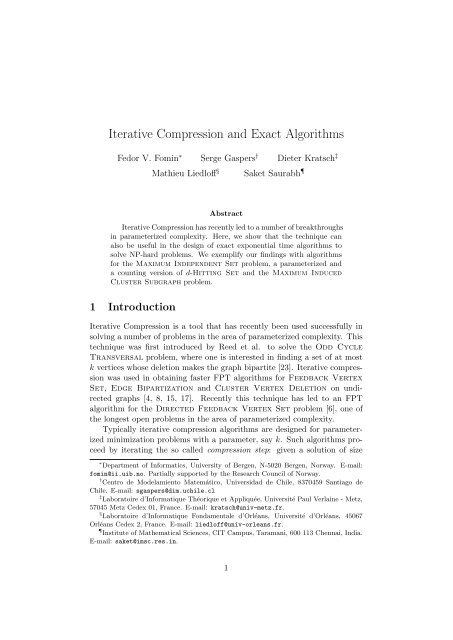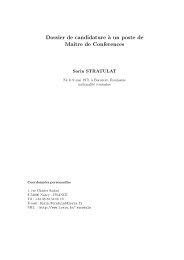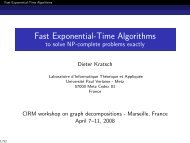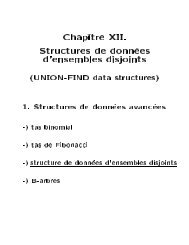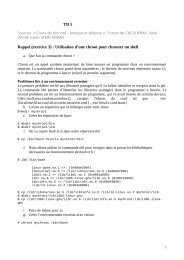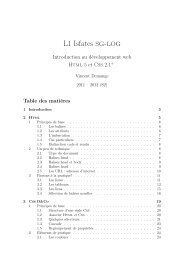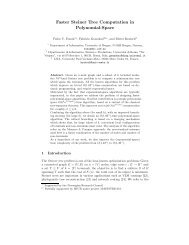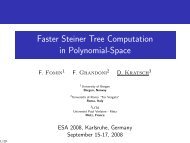Iterative Compression and Exact Algorithms - Lita
Iterative Compression and Exact Algorithms - Lita
Iterative Compression and Exact Algorithms - Lita
You also want an ePaper? Increase the reach of your titles
YUMPU automatically turns print PDFs into web optimized ePapers that Google loves.
<strong>Iterative</strong> <strong>Compression</strong> <strong>and</strong> <strong>Exact</strong> <strong>Algorithms</strong>Fedor V. Fomin ∗ Serge Gaspers † Dieter Kratsch ‡Mathieu Liedloff § Saket Saurabh Abstract<strong>Iterative</strong> <strong>Compression</strong> has recently led to a number of breakthroughsin parameterized complexity. Here, we show that the technique canalso be useful in the design of exact exponential time algorithms tosolve NP-hard problems. We exemplify our findings with algorithmsfor the Maximum Independent Set problem, a parameterized <strong>and</strong>a counting version of d-Hitting Set <strong>and</strong> the Maximum InducedCluster Subgraph problem.1 Introduction<strong>Iterative</strong> <strong>Compression</strong> is a tool that has recently been used successfully insolving a number of problems in the area of parameterized complexity. Thistechnique was first introduced by Reed et al. to solve the Odd CycleTransversal problem, where one is interested in finding a set of at mostk vertices whose deletion makes the graph bipartite [23]. <strong>Iterative</strong> compressionwas used in obtaining faster FPT algorithms for Feedback VertexSet, Edge Bipartization <strong>and</strong> Cluster Vertex Deletion on undirectedgraphs [4, 8, 15, 17]. Recently this technique has led to an FPTalgorithm for the Directed Feedback Vertex Set problem [6], one ofthe longest open problems in the area of parameterized complexity.Typically iterative compression algorithms are designed for parameterizedminimization problems with a parameter, say k. Such algorithms proceedby iterating the so called compression step: given a solution of size∗ Department of Informatics, University of Bergen, N-5020 Bergen, Norway. E-mail:fomin@ii.uib.no. Partially supported by the Research Council of Norway.† Centro de Modelamiento Matemático, Universidad de Chile, 8370459 Santiago deChile. E-mail: sgaspers@dim.uchile.cl‡ Laboratoire d’Informatique Théorique et Appliquée, Université Paul Verlaine - Metz,57045 Metz Cedex 01, France. E-mail: kratsch@univ-metz.fr.§ Laboratoire d’Informatique Fondamentale d’Orléans, Université d’Orléans, 45067Orléans Cedex 2, France. E-mail: liedloff@univ-orleans.fr. Institute of Mathematical Sciences, CIT Campus, Taramani, 600 113 Chennai, India.E-mail: saket@imsc.res.in.1
k +1, either compress it to a solution of size k or prove that there is no solutionof size k. To obtain a fixed parameter tractable (FPT) algorithm, onehas to solve the compression step in time f(k)n O(1) ,wheref is an arbitrarycomputable function, k is a parameter <strong>and</strong> n is the length of the input. Technicallyspeaking, almost all the iterative compression based FPT algorithmswith parameter k have f(k) ≥ 2 k+1 , as they all branch on all partitions(A, D) of a k + 1 sized solution S <strong>and</strong> look for a solution of size k with therestriction that it should contain all elements of A <strong>and</strong> none of D.Given the success of iterative compression in designing fixed parametertractable algorithms, it is natural <strong>and</strong> tempting to study its applicability indesigning exact exponential time algorithms solving computationally hardproblems. The goal of the design of such algorithms is to establish algorithmsof best possible worst-case running time; at least provably faster than theone of enumerating all prospective solutions, or loosely speaking, algorithmsbetter than trivial enumeration. For example, for many NP-hard or #P-hardproblems on graphs on n vertices <strong>and</strong> m edges the prospective solutions areeither subsets of vertices (or edges). Thus a trivial algorithm to solve suchan NP-hard problem basically enumerates all subsets of vertices (or edges)<strong>and</strong> finds an optimal solution or all optimal solutions, counts the numberof optimal solutions, or enumerates all optimal solutions. This mostly leadsto algorithms of time complexity 2 n (or 2 m ), modulo some polynomial factors.Our aim is to demonstrate that iterative compression can become auseful tool in the design of exact exponential time algorithms as well; weconcentrate on optimization <strong>and</strong> counting problems.One simple way to obtain an exact exponential time algorithm from anFPT algorithm is to use the latter for all possible values of the parameter k.In many cases this does not lead to faster exact algorithms. Assuming thatthe largest (reasonable) value of the parameter k is at least n, using a typicaliterative compression based FPT algorithm does not seem to be of much usefor constructing an exact exponential time algorithm because we would endup with an algorithm for the compression step having a factor of 2 n (or 2 m )in its worst-case running time; <strong>and</strong> hence the established algorithm wouldnot be better than trivial enumeration.There are various well-known techniques to design exact exponentialtime algorithms for decision, optimization, counting or enumeration problemssuch as branching algorithms, dynamic programming (over subsets)<strong>and</strong> inclusion-exclusion algorithms. (We refer the interested reader to [27].)<strong>Iterative</strong> compression provides combinatorial algorithms based on certainstructural properties of the problem (in the compression step). While theimprovement in the running time compared to (complicated) branching algorithmsis not so impressive, the simplicity <strong>and</strong> elegance of the argumentsallow them to be used in a basic algorithms course. We find this worth emphasisingsince, despite several exceptions (like the works of Björklund et al.2
[1, 2, 19]), the area of exact algorithms is heavily dominated by branchingalgorithms, in particular, for subset problems. It is very often the case thatan (incremental) improvement in the running time of a branching algorithmrequires an extensive case analysis, which becomes very technical <strong>and</strong> tedious.The analysis of such algorithms can also be very complicated <strong>and</strong>even computer based.To our knowledge, this paper is the first attempt to use iterative compressionoutside the domain of FPT algorithms. We exemplify this approachby the following results:1. We show how to solve Maximum Independent Set for a graph onn vertices in time O(1.3196 n ). While the running time of our iterativecompression algorithm is higher than the running times of modernbranching algorithms [12, 13, 24], this simple algorithm serves as anintroductory example to more complicated applications of the method.2. We obtain algorithms counting the number of minimum hitting sets ofa family of sets of an n-element ground set in time O(1.7198 n ), whenthe size of each set is at most 3 (#Minimum 3-Hitting Set). For#Minimum 4-Hitting Set we obtain an algorithm of running timeO(1.8997 n ). For Minimum 4-Hitting Set similar ideas lead to analgorithm of running time O(1.8704 n ). These algorithms are fasterthan the best algorithms known for these problems so far [11, 22].3. We provide an algorithm to solve the Maximum Induced ClusterSubgraph problem in time O ∗ (φ n )whereφ =(1+ √ 5)/2 < 1.6181is the golden ratio. The only previous algorithm for this problem weare aware of is a very complicated branching algorithm of Wahlström[26] for solving 3-Hitting Set (let us note that Maximum InducedCluster Subgraph is a special case of 3-Hitting Set, whereeverysubset is a set of vertices inducing a path of length three), which resultsin a running time of O(1.6278 n ).As a byproduct, we provide FPT algorithms for the (k, d)-Hitting Setproblem, where the input is a family of sets of size at most d, the parameter isk, <strong>and</strong> the task is to find a hitting set of size at most k if one exists. For d =4<strong>and</strong> d = 5 we achieve the respective running times O(3.0755 k · n O(1) ) <strong>and</strong>O(4.0755 k ·n O(1) ), improving the best known algorithms for these cases [11].2 Maximum Independent SetMaximum Independent Set (MIS) is one of the well studied problems inthe area of exact exponential time algorithms <strong>and</strong> many papers have beenwritten on this problem [12, 13, 24, 25]. It is customary that if we develop a3
new method then we first apply it to well known problems in the area. Here,as an introductory example, we consider the NP-complete problem MIS.Maximum Independent Set (MIS): Given a graph G =(V,E) on nvertices, find a maximum independent set of G. An independent set ofG is a set of vertices I ⊆ V such that no two vertices of I are adjacentin G. Amaximum independent set is an independent set of maximumsize.It is well-known that I is an independent set of a graph G iff V \ I is avertex cover of G, i.e. every edge of G has at least one end point in V \ I.Therefore Minimum Vertex Cover (MVC) is the complement of MIS inthe sense that I is a maximum independent set of G iff V \ I is a minimumvertex cover of G. This fact implies that when designing exponential timealgorithms we may equivalently consider MVC. Weproceedbydefiningacompression version of the MVC problem.Comp-MVC: Given a graph G =(V,E) withavertexcoverS ⊆ V , find a vertex cover of G of size at most |S| −1 if oneexists.Note that if we can solve Comp-MVC efficiently then we can solve MVCefficiently by repeatedly applying an algorithm for Comp-MVC as follows.Given a graph G =(V,E) on n vertices with V = {v 1 ,v 2 ,...,v n },letG i =G[{v 1 ,v 2 ,...,v i }] <strong>and</strong> let C i be a minimum vertex cover of G i . By V i wedenote the set {v 1 ,v 2 ,...,v i }. We start with G 1 <strong>and</strong> put C 1 = ∅. Supposethat we already have computed C i for the graph G i for some i ≥ 1. We forman instance of Comp-MVC with input graph G i+1 <strong>and</strong> S = C i ∪{v i+1 }.In this stage we either compress the solution S which means that we find avertex cover S of G i+1 of size |S|−1 <strong>and</strong> put C i+1 = S , or (if there is nosuch S )weputC i+1 = S.Our algorithm is based on the following lemma.Lemma 1. Let G i+1 <strong>and</strong> S be given as above. If there exists a vertex coverC i+1 of G i+1 of size |S|−1, then it can be partitioned into two sets A <strong>and</strong>B such that(a) A ⊂ S, |A| ≤|S|−1 <strong>and</strong> A is a minimal vertex cover of G i+1 [S].(b) B ⊆ (V i+1 \A) is a minimum vertex cover of the bipartite graph G i+1 [V i+1 \A].Proof. Let C i+1 be a vertex cover of G i+1 of size |S| −1. Its complementV i+1 \C i+1 is an independent set. We define A = C i+1 ∩S <strong>and</strong> B = C i+1 \A .Then A is a vertex cover of G i+1 [S] <strong>and</strong> |A |≤|S| −1. Let A ⊆ A be aminimal vertex cover of G i+1 [S]. We define B = B ∪ (A \ A). Since A isa minimal vertex cover of G i+1 [S], we have that S \ A is an independentset. This in turn implies that G i+1 [V i+1 \ A] is a bipartite graph (with a4
ipartition S\A <strong>and</strong> V i+1 \S). Finally, since C i+1 is a minimum vertex coverof G i+1 , we conclude that B is a minimum vertex cover of G i+1 [V i+1 \A].Lemma 1 implies that the following algorithm solves Comp-MVC correctly.Step 1: Enumerate all minimal vertex covers of size at most |S| −1 ofG i+1 [S] as a possible c<strong>and</strong>idate for A.Step 2: For each minimal vertex cover A find a minimum vertex cover B ofthe bipartite graph G i+1 [V i+1 \A] (via the computation of a maximummatching in this bipartite graph [16]).Step 3: If the algorithm finds a vertex cover A ∪ B of size |S|−1inthisway, set C i+1 = A ∪ B, elsesetC i+1 = S.Steps 2 <strong>and</strong> 3 of the algorithm can be performed in polynomial time, <strong>and</strong> therunning time of Step 1, which is exponential, dominates the running time ofthe algorithm. To enumerate all maximal independent sets or equivalentlyall minimal vertex covers of a graph in Step 1, one can use the polynomialdelayalgorithm of Johnson et al. [18].Proposition 2 ([18]). All maximal independent sets of a graph can be enumeratedwith polynomial delay.For the running time analysis of the algorithm we need the following boundson the number of maximal independent sets or minimal vertex covers dueto Moon <strong>and</strong> Moser [20] <strong>and</strong> Byskov [3].Proposition 3 ([20]). A graph on n vertices has at most 3 n/3 maximalindependent sets.Proposition 4 ([3]). The maximum number of maximal independent setsof size at most k in any graph on n vertices for k ≤ n/3 isN[n, k] =n/k (n/k+1)k−n (n/k + 1) n−n/kk .Moreover, all such sets can be enumerated in time O ∗ (N[n, k]). 1Sincemax max0≤α≤3/4 (3αn/3 ), max (N[αn, (1 − α)n]) = O ∗ (2 2n/5 ),3/4 0, we omit polynomial factors in the big-Oh notation everytime we round the base of the exponent.5
we have that by Propositions 2, 3, <strong>and</strong> 4, all minimal vertex covers of G i+1 [S]of size at most |S|−1 can be listed in time O ∗ (2 2n/5 )=O(1.3196 n ).Thus, the overall running time of the algorithm solving Comp-MVC isO(1.3196 n ). Since the rounding of the base of the exponent dominates thepolynomial factor of the other steps of the iterative compression, we obtainthe following theorem.Theorem 5. The given algorithm for the problems Maximum IndependentSet <strong>and</strong> Minimum Vertex Cover, established by iterative compression,has running time O(1.3196 n ) on graphs of n vertices.3 #d-Hitting Set <strong>and</strong> parameterized d-Hitting SetThe Hitting Set problem is a generalization of Vertex Cover. Here,given a family of sets over a ground set of n elements, the objective is to hitevery set of the family with as few elements of the ground set as possible.We study a version of the hitting set problem where every set in the familyhas at most d elements.Minimum d-Hitting Set (MHS d ): Given a universe V of n elements<strong>and</strong> a collection C of subsets of V of size at most d, findaminimumhitting set of C. Ahitting set of C is a subset V ⊆ V such that everysubset of C contains at least one element of V .A counting version of the problem is #Minimum d-Hitting Set (#MHS d )that asks for the number of different minimum hitting sets. We denote aninstance of #MHS d by (V,C). Furthermore we assume that for every v ∈ V ,there exists at least one set in C containing it.We show how to obtain an algorithm to solve #MHS d using iterativecompression which uses an algorithm for #MHS d−1 as a subroutine. Firstwe define the compression version of the #MHS d problem.Comp-#d-Hitting Set: Given a universe V of n elements,a collection C of subsets of V of size at most d, <strong>and</strong> a (notnecessarily minimum) hitting set H ⊆ V of C, findaminimumhitting set H of C <strong>and</strong> compute the number of all minimumhitting sets of C.Lemma 6. Let O ∗ (a n d−1) be the running time of an algorithm solving#MHS d−1 , where a d−1 > 1 is some constant. Then Comp-#d-HittingSet can be solved in time O ∗ 2 |H| a |V |−|H |d−1.Moreover, if |H | is greater than 2|V |/3 <strong>and</strong> the minimum size of a hittingset in C is at least |H |−1, then Comp-#d-Hitting Set can be solved in6
timeO ∗ |H |2|H |−|V |a |V |−|H |d−1Proof. To prove the lemma, we give an algorithm that, for each possiblepartition (N, ¯N) of H , computes a minimum hitting set H N <strong>and</strong> the numberh N of minimum hitting sets subject to the constraint that these hitting setscontain all the elements of N <strong>and</strong> none of the elements of ¯N.For every partition (N, ¯N) of H , we either reject it as invalid or wereduce the instance (V,C) to an instance (V , C ) by applying the followingtwo rules in the given order.(H) If there exists a set C i ∈Csuch that C i ⊆ ¯N then we refer to such apartition as invalid <strong>and</strong> reject it.(R) For all sets C i with C i ∩ N = ∅ put C = C\C i . In other words, all setsof C, which are already hit by N, are removed.Rule (H) is sound because if a set C i ⊆Cis included in ¯N then no H ⊆ V \ ¯Ncontains an element of C i <strong>and</strong> thus there is no hitting set H ⊆ V \ ¯N. Ifa partition (N, ¯N) of H is not invalid based on rule (R) then the instance(V,C) can be reduced to the instance I =(V , C ), where V = V \ H <strong>and</strong>C = {X ∩ V | X ∈C<strong>and</strong> X ∩ N = ∅}.Summarizing, the instance I is obtained by removing all the elements ofV for which it has already been decided if they are part of H N or not <strong>and</strong> allthe sets that are hit by the elements in N. To complete H N ,itissufficienttofind a minimum hitting set of I <strong>and</strong> to count the number of minimum hittingsets of I . The crucial observation here is that I is an instance of #MHS d−1 .Indeed, H is a hitting set of (V,C) <strong>and</strong> by removing it we decrease thesize of every set at least by one. Therefore, we can use an algorithm for#MHS d−1 to complete this step. When checking all partitions (N, ¯N) ofH it is straightforward to keep the accounting information necessary tocompute a minimum hitting set H <strong>and</strong> to count all minimum hitting sets.Thus for every partition (N, ¯N) of H the algorithm solving #MHS d−1is called for the instance I . There are 2 |H| partitions (N, ¯N) of the vertexset H . For each such partition, the number of elements of the instance I is |V | = |V \ H | = |V |−|H |. Thus, the running time of the algorithm isO ∗ 2 |H| a |V |−|H |.d−1If |H | > 2|V |/3 <strong>and</strong> the minimum size of a hitting set in C is at least|H |−1, then it is not necessary to check all partitions (N, ¯N) of H as thenumber of relevant partitions of H becomes significantly smaller than 2 |H| ,<strong>and</strong> in this case we can speed up the algorithm. Indeed, since• |H |≥| H|≥|H |−1, <strong>and</strong>• | H ∩ (V \ H )|≤|V |−|H |,.7
it is sufficient to consider only those partitions (N, ¯N) of H such that|N| ≥|H |−1 − (|V |−|H |)=2|H |−|V |−1. In this case, the running time of the algorithm is O ∗ |H | |V |−|H2|H |−|V | a |d−1.The following lemma will be useful for the forthcoming running-time analysis.Lemma 7. Let n be a natural number <strong>and</strong> a be a non-negative constant.The sum of the terms j2j−na n−j for j =0, 1,...,n is upper bounded by n O ∗ .1+ √ 1+4a d−12Proof. Let j = n − m. Then j2j−na n−j can be rewritten as g(n, m) = n−mn−2m a m = n−mm a m . By convention, we set g(n, m) =0whenevern 2i/3, the running time is8
O ∗ max j 2i/3 2i/3, <strong>and</strong> 1 ≤i ≤ n, ja i−j2j − id−1 ≤ j2j − na n−jd−1 ,the worst case running time of the algorithm isOmax∗ max1≤i≤n 22i/3 a i/3jd−1 , max2n/3≤j≤n 2j − na n−jd−1.Finally, 2n/3 n/3 =2 2n/3 up to a polynomial factor, <strong>and</strong> thus the running time is O ∗ max j 2n/3≤j≤n 2j−n an−jd−1. By Lemma 7, this latest expression is n bounded by O ∗ .1+ √ 1+4a d−12Based on the O(1.2377 n ) algorithm for #MHS 2 [26], we establish thefollowing corollary :Corollary 9. #MHS 3 can be solved in time O(1.7198 n ).The same approach can be used to design an algorithm for the optimizationversion MHS d , assuming that an algorithm for MHS d−1 is available. Basedon the O(1.6278 n ) algorithm for MHS 3 [26] this leads to an O(1.8704 n )timealgorithm for solving MHS 4 .Corollary 10. MHS 4 can be solved in time O(1.8704 n ).In the following theorem we provide an alternative approach to solve #MHS d .This is a combination of brute force enumeration (for sufficiently large hittingsets) with one application of the compression algorithm of Lemma 6.For large values of a d−1 , more precisely for a d−1 ≥ 1.6553, this new approachgives faster algorithms than the one obtained by Theorem 8.Theorem 11. Suppose there exists an algorithm with running time O ∗ (a n d−1 ),1
d #MHS d MHS d2 O(1.2377 n ) [26] O(1.2108 n ) [24]3 O(1.7198 n ) O(1.6278 n ) [26]4 O(1.8997 n ) O(1.8704 n )5 O(1.9594 n ) O(1.9489 n )6 O(1.9824 n ) O(1.9781 n )7 O(1.9920 n ) O(1.9902 n )Table 1: Running times of the algorithms for #MHS d <strong>and</strong> MHS d .In the second case, there exists a hitting set of size αn. Then countall minimum hitting sets using the compression algorithm of Lemma 6 withH being a hitting set of size αn found by the enumeration phase. ByLemma 6, this phase of the algorithm has running time O ∗ 2 αn a n−αn d−1 .The best running times of algorithms solving #MHS d <strong>and</strong> MHS d are summarizedin Table 1. For #MHS ≥4 <strong>and</strong> MHS ≥5 , we use the algorithm ofTheorem 11. Note that the MHS 2 problem is equivalent to MVC <strong>and</strong> MIS.Finally, it is worth to note that the technique can also be used to solve theparameterized version of d-Hitting Set. Namely, we consider the followingproblem:(k, d)-Hitting Set (k-HS d ): Given a universe V of n elements, acollection C of subsets of V of size at most d <strong>and</strong> an integer k, findahitting set of size at most k of C, if one exists.Theorem 12. Suppose there exists an algorithm to solve k-HS d−1 in timeO(a k d−1 · nO(1) ), where a d−1 ≥ 1. Then k-HS d can be solved in time O((1 +a d−1 ) k · n O(1) ).Proof. The proof is very similar to the one of Theorem 8 except that thesize of a solution is now bounded by the parameter k instead of n. GivenauniverseV = {v 1 ,v 2 ,...,v n } <strong>and</strong> a collection C, for i =1, 2,...,n,letV i = {v 1 ,v 2 ,...,v i } <strong>and</strong> C i = {X ∈ C | X ⊆ V i }. Then I i = (V i , C i )constitutes an instance of k-HS d for the i th stage of the iteration. Wedenote by H i a hitting set of size at most k, if one exists, of the instance I i .Clearly, if {v 1 }∈C,thenH 1 = {v 1 } (assuming that k ≥ 1); otherwiseH 1 = ∅ <strong>and</strong> h 1 = 0.Consider now the i th stage of the iteration. The relation |H i−1 |≤|H i |≤|H i−1 | +1≤ k + 1 holds since at least |H i−1 | elements are needed to hit allthe sets of I i except those containing element v i <strong>and</strong> H i−1 ∪{v i } is a hittingset of I i .10
d k-HS d2 O(1.2738 k · n O(1) ) [5]3 O(2.0755 k · n O(1) ) [26]4 O(3.0755 k · n O(1) )5 O(4.0755 k · n O(1) )6 O(5.0640 k · n O(1) ) [11]7 O(6.0439 k · n O(1) ) [11]Table 2: Running times of the best known algorithms solving k-HS d forvarious values of d. The algorithms for 4 ≤ d ≤ 5 are based on corollary 13.As we did in Lemma 6, for every partition (N, ¯N) of H i−1 ∪{v i } weapply the rules (H) <strong>and</strong> (R) (see the proof of Lemma 6). Each not rejectedpartition (N, ¯N) leads to an instance Ii =(V i ,C i ) of k-HS d−1, whereVi =V i \ (H i−1 ∪{v i }) <strong>and</strong> Ci = {X ∩ V i | X ∈C i <strong>and</strong> X ∩ N = ∅}. Thus,by using an algorithm for k-HS d−1 , a solution for of size at most kIi canbefound, if one exists. The overall running time is given by the formulak k+1i=0 i ak−id−1 ≤ 2 · (1 + a d−1) k .In particular, an immediate consequence of the previous theorem is thefollowing :Corollary 13. Suppose there exists an algorithm to solve k-HS 3 in timeO(a k 3 · nO(1) ). Then, for any fixed d ≥ 4, k-HS d can be solved in timeO((a 3 + d − 3) k · n O(1) ).By using an O(2.0755 k · n O(1) ) algorithm by Wahlström [26] for solvingk-HS 3 , we obtain the running times depicted in Table 2 for d = 4 <strong>and</strong> d = 5,which are, up to our knowledge, the best known algorithms.4 Maximum Induced Cluster SubgraphClustering objects according to given similarity or distance values is an importantproblem in computational biology with diverse applications, e.g., indefining families of orthologous genes, or in the analysis of microarray experiments[7, 10, 14, 17, 21]. A graph theoretic formulation of the clusteringproblem is called Cluster Editing. To define this problem we need tointroduce the notion of a cluster graph. A graph is called a cluster graph ifit is a disjoint union of cliques. In the most common parameterized versionof Cluster Editing the problem is stated as follows. The input is a graphG =(V,E) <strong>and</strong> a positive integer integer k, the parameter. The task isto find out whether the input graph G can be transformed into a cluster11
In Step 2, we reduce the problem of finding a maximum sized C to theproblem of finding a maximum weight matching in an auxiliary bipartitegraph. Independent of our work, Hüffner et al. [17] also use this natural ideaof reduction to weighted bipartite matching to obtain an FPT algorithm forthe vertex weighted version of Cluster Vertex Deletion using iterativecompression. For completeness, we present the details of Step 2.If G[N] contains an induced P 3 then there is obviously no C ⊆ V inducinga cluster graph that respects the partition (N, ¯N). We call such apartition invalid.Otherwise, G[N] is a cluster graph, <strong>and</strong> thus the goal is to find a maximumsize subset C of S = V \ S such that G[C ∪ N] is a cluster graph.Fortunately, such a set C can be computed in polynomial time by reducingthe problem to finding a maximum weight matching in an auxiliary bipartitegraph.First we describe the construction of the bipartite graph. Consider thegraph G[N ∪ S] <strong>and</strong> note that G[N] <strong>and</strong> G[S] are cluster graphs. Now thefollowing reduction rule is applied to the graph G[N ∪ S].(R) Remove every vertex b ∈ S for which G[N ∪{b}] contains an inducedP 3 .Clearly all vertices removed by (R) cannot belong to any C inducing acluster subgraph of G. Let Ŝ be the subset of vertices of S which are notremoved by (R). Hence the current graph is G[N ∪ Ŝ]. Clearly G[Ŝ] isa cluster graph since G[S] is one. Further, note that no vertex of Ŝ hasneighbors in two different maximal cliques of G[N] <strong>and</strong> if a vertex of Ŝ hasa neighbor in one maximal clique of G[N] then it is adjacent to each vertexof this maximal clique. Thus, every vertex in Ŝ has either no neighbor in Nor it is adjacent to all the vertices of exactly one maximal clique of G[N].Now we are ready to define the auxiliary bipartite graph G =(A, B, E ).Let {C 1 , C 2 , ··· , C r } be the maximal cliques of the cluster graph G[N]. Let{C1 , C 2 , ··· , C s} be the maximal cliques of the cluster graph G[Ŝ]. Let A ={a 1 ,a 2 ,...,a r ,a 1 ,a 2 ,...,a s} <strong>and</strong> B = {b 1 ,b 2 ,...,b s }. Here, for all i ∈{1,...,r}, each maximal clique C i of G[N] isrepresentedbya i ∈ A; <strong>and</strong> forall j ∈{1, 2,...,s}, each maximal clique Cj of G[Ŝ] isrepresentedbya j ∈ A<strong>and</strong> by b j ∈ B.Now there are two types of edges in G : a j b k ∈ E if there is a vertexu ∈Ck such that u has a neighbor in C j, <strong>and</strong> a j b j ∈ E if there is a vertexu ∈Cj such that u has no neighbor in N. Finally we define the weightsfor both types of eges in the bipartite graph G . For an edge a j b k ∈ E ,itsweight w(a j b k ) is the number of vertices in Ck being adjacent to all verticesof the maximal clique C j . For an edge a j b j, its weight w(a j b j)isthenumberof vertices in Cj without any neighbor in N.This transformation is of interest due to the following claim that usesthe above notation.13
Claim. The maximum size of a subset C of Ŝ such that G[N ∪ C ]isacluster subgraph of the graph G ∗ = G[N ∪ Ŝ] is equal to the maximum totalweight of a matching in the bipartite graph G =(A, B, E ).Proof. We first show that any matching in G corresponds to a set Y ⊆ Ŝthat together with N induces a cluster subgraph of G ∗ , that is, G[N ∪ Y ]isa P 3 -free graph. To see this, let M = {e 1 ,e 2 ,...,e t } be a matching in G .Now if e l = a j b k then Y l is the set of vertices in Ck which are adjacent to allvertices of the maximal clique C j .Otherwise,ife l = a j b j then Y l is the setof vertices in Cj which have no neighbor in N. Now let us put Y = tl=1 Y l.Clearly, |Y | = tl=1 w(e l). Now we claim that G[N ∪ Y ] is a disjoint unionof cliques. To the contrary, suppose there exists an induced P 3 in G[N ∪ Y ],say P = xyz is an induced P 3 in G[N ∪Y ]. Then two of the vertices of P arein Y <strong>and</strong> one in N because of rule (R) <strong>and</strong> the fact that G[Ŝ] isaclustergraph. First let x, z ∈ Y <strong>and</strong> y ∈ N <strong>and</strong> x ∈Ct 1, y ∈C t2 <strong>and</strong> z ∈Ct 3.Thismeans selecting edges a t2 b t1 <strong>and</strong> a t2 b t3 in M. Secondly, let x, y ∈ Y <strong>and</strong>z ∈ N, <strong>and</strong> thus x <strong>and</strong> y belong to the same clique Ct 1, <strong>and</strong> z ∈C t2 . Thismeans having edges a t2 b t1 <strong>and</strong> a t 1b t1 in M. In both cases this contradicts Mbeing a matching. Consequently if there is a matching M in G ∗ of weightk then there is a set Y ⊆ Ŝ of size k such that G[N ∪ Y ] is a cluster graph.To prove the other direction, let {F 1 , F 2 , ··· , F q } be the maximal cliquesof the cluster graph G[C ], <strong>and</strong> let {F1 , F 2 , ··· , F p} be the maximal cliquesof the cluster graph G[N ∪ C ]. Clearly, each Fj ,1≤ j ≤ p, contains atmost one of {F l:1≤ l ≤ q}. Let π(l) be the integer such that F l ⊆Fπ(l) .If F l = Fπ(l) then put e l = a l b l. Otherwise, if F l ⊂Fπ(l) then put e l =a π(l) b l . Since π is injective, M = {e 1 ,e 2 ,...,e q } is a matching in G <strong>and</strong>the definition of the weights of the edges in G implies that the total weightof M is ql=1 w(e l)=|C |. Thus there is a matching of G of total weight|C |.Note that the construction of the bipartite graph G , including the applicationof (R) <strong>and</strong> the computation of a maximum weighted matching of G can be performed in time O(n 3 ) [9]. Thus, the running time of the algorithmin Case 1 is the time needed to enumerate all subsets of S (whose size isbounded by 2n/3) <strong>and</strong> this time is O ∗ (2 2n/3 )=O(1.5875 n ).Case 2: If |S| > 2n/3 then the algorithm needs to find a P 3 -HS of G ofsize |S|−1, or show that none exists.The algorithm proceeds as in the first case. Note that at most n −|S|vertices of V \ S can be added to N. Therefore, the algorithm verifies onlythose partitions (N, ¯N) of S satisfying |N| ≥|S|−1−(n−|S|) =2|S|−n−1.In this second case, the worst-case running time is O ∗ αnmax2/3
<strong>and</strong> by Lemma 7 being no more than O ∗ (φ n )whereφ =(1+ √ 5)/2.Now we are ready to prove the following theorem using iterative compression.Theorem 16. Given a graph on n vertices, MICS can be solved in timeO ∗ (φ n ) where φ =(1+ √ 5)/2 < 1.6181 is the golden ratio.Proof. Given a graph G =(V,E) withvertexsetV = {v 1 ,v 2 ,...,v n },letV i = {v 1 ,v 2 ,...,v i } <strong>and</strong> let C i be a maximum induced cluster subgraph ofG i = G[V i ]. Let S i = V i \ C i .The algorithm starts with G 1 , C 1 = {v 1 } <strong>and</strong> S 1 = ∅. Atthei th iterationof the algorithm, 1 ≤ i ≤ n, we maintain the invariant that we have at ourdisposal C i−1 a maximum set inducing a cluster subgraph of G i−1 <strong>and</strong> S i−1aminimumP 3 -HS of G i−1 . Note that S i−1 ∪{v i } is a P 3 -HS of G i <strong>and</strong>that no P 3 -HS of G i has size smaller than |S i−1 |. Now use the algorithmof Lemma 15 to solve Comp-MICS on G i with S = S i−1 ∪{v i }.Thentheworst-case running time is attained at the n th stage of the iteration <strong>and</strong> therun time is O ∗ (φ n )whereφ =(1+ √ 5)/2.5 Conclusion<strong>Iterative</strong> compression is a technique which is succesfully used in the design ofFPT algorithms. In this paper we show that this technique can also be usedto design exact exponential time algorithms. This suggests that it mightbe used in other areas of algorithms as well. For example, how useful caniterative compression be in the design of approximation algorithms?Carrying over techniques from the design of FPT algorithms to the designof exact exponential time algorithms <strong>and</strong> vice-versa is a natural <strong>and</strong>tempting idea. A challenging question in this regard is whether Measure<strong>and</strong> Conquer, a method that has been succesfully used to improve the timeanalysis of simple exponential-time branching algorithms, can be adaptedfor the analysis of FPT branching algorithms.Acknowledgements. The authors are grateful to an anonymous refereefor many suggestions helping us to improve the presentation of the paper.References[1] A. Björklund <strong>and</strong> T. Husfeldt, Inclusion–Exclusion <strong>Algorithms</strong> forCounting Set Partitions, in the proceedings of FOCS’06, 575–582(2006).[2] A. Björklund, T. Husfeldt, P. Kaski, <strong>and</strong> M. Koivisto, Fourier meetsMöbius: Fast Subset Convolution, in the proceedings of STOC’07, 67–74 (2007).15
[3] J. M. Byskov, Enumerating maximal independent sets with applicationsto graph colouring, Oper. Res. Lett. 32(6), 547–556 (2004).[4] J. Chen, F. V. Fomin, Y. Liu, S. Lu, <strong>and</strong> Y. Villanger, Improved<strong>Algorithms</strong> for Feedback Vertex Set Problems, J. Comp. Syst. Sci. 74,2008, pp. 1188–1198.[5] J. Chen, I. A. Kanj, G. Xia, Improved Parameterized Upper Boundsfor Vertex Cover, in the proceedings of MFCS’06, 238–249 (2006).[6] J. Chen, Y. Liu, S. Lu, I. Razgon, B. O’Sullivan, A Fixed-Parameter Algorithmfor the Directed Feedback Vertex Set Problem, J. ACM 55(5),(2008).[7] F. Dehne, M. A. Langston, X. Luo, S. Pitre, P. Shaw <strong>and</strong> Y. Zhang,The Cluster Editing Problem: Implementations <strong>and</strong> Experiments, inthe proceedings of IWPEC’06, 13-24 (2006).[8] F. Dehne, M. Fellows, M. Langston, F. Rosamond, <strong>and</strong> K. Stevens,An O(2 O(k) n 3 ) FPT algorithm for the undirected feedback vertex setproblem, Theory Comput. Syst. 41(3), 479–492 (2007).[9] J. Edmonds <strong>and</strong> R. M. Karp, Theoretical improvements in algorithmicefficiency for network flow problems, J. ACM 19(2), 248–264 (1972).[10] M. R. Fellows, M. A. Langston, F. A. Rosamond <strong>and</strong> P. Shaw, EfficientParameterized Preprocessing for Cluster Editing, in the proceedings ofFCT’07, 312-321 (2007).[11] H. Fernau, Parameterized <strong>Algorithms</strong> for Hitting Set: The WeightedCase, in the proceedings of CIAC’06, 332-343 (2006).[12] F. V. Fomin, F. Gr<strong>and</strong>oni, <strong>and</strong> D. Kratsch, Measure <strong>and</strong> conquer:AsimpleO(2 0.288 n ) independent set algorithm, in the proceedings ofSODA’06, 18–25 (2006).[13] F. V. Fomin, F. Gr<strong>and</strong>oni, <strong>and</strong> D. Kratsch, A measure & conquer approachfor the analysis of exact algorithms, J. ACM 56(5), (2009).[14] J. Guo, A more effective linear kernelization for cluster editing, Theor.Comput. Sci. 410(8-10), 718–726 (2009).[15] J. Guo, J. Gramm, F. Hüffner, R. Niedermeier, <strong>and</strong> S. Wernicke.<strong>Compression</strong>-based fixed-parameter algorithms for feedback vertex set<strong>and</strong> edge bipartization, J. Comput. Syst. Sci. 72(8), 1386–1396 (2006).[16] J. E. Hopcroft <strong>and</strong> R. M. Karp, An n 5/2 algorithm for maximum matchingin bipartite graphs, SIAM J. Computing 2(4), 225–231 (1973).16
[17] F. Hüffner, C. Komusiewicz, H. Moser, <strong>and</strong> R. Niedermeier, Fixedparameteralgorithms for cluster vertex deletion, in the proceedings ofLATIN’08, 711-722 (2008).[18] D. S. Johnson, C. H. Papadimitriou, <strong>and</strong> M. Yannakakis, On GeneratingAll Maximal Independent Sets, Inf. Process. Lett. 27(3), 119–123(1988).[19] M. Koivisto, An O(2 n ) Algorithm for Graph Colouring <strong>and</strong> OtherPartitioning Problems via Inclusion-Exclusion, in the proceedings ofFOCS’06, 583–590 (2006).[20] J. W. Moon <strong>and</strong> L. Moser, On Cliques in Graphs, Israel J. Mathematics3, 23–28 (1965).[21] S. Rahmann, T. Wittkop, J. Baumbach, M. Martin, A. Trub <strong>and</strong>S. Böcker, <strong>Exact</strong> <strong>and</strong> Heuristic <strong>Algorithms</strong> for Weighted Cluster Editing,in the proceedings of Comput. Syst. Bioinformatics Conference’07,6 (1), 391-401 (2007).[22] V. Raman, S. Saurabh, <strong>and</strong> S. Sikdar, Efficient <strong>Exact</strong> <strong>Algorithms</strong>through Enumerating Maximal Independent Sets <strong>and</strong> Other Techniques,Theory Comput. Syst. 41(3), 1432-4350 (2007).[23] B. A. Reed, K. Smith, <strong>and</strong> A. Vetta, Finding odd cycle transversals,Oper. Res. Lett. 32 (4), 299-301 (2004).[24] J. M. Robson, <strong>Algorithms</strong> for maximum independent sets, J. <strong>Algorithms</strong>7, 425–440 (1986).[25] R. Tarjan <strong>and</strong> A. Trojanowski, Finding a maximum independent set,SIAM J. Computing 6(3), 537–546 (1977).[26] M. Wahlström, <strong>Algorithms</strong>, measures <strong>and</strong> upper bounds for satisfiability<strong>and</strong> related problems, PhD thesis, Linköping University, Sweden(2007).[27] G. J. Woeginger, <strong>Exact</strong> algorithms for NP-hard problems: A survey, inCombinatorial Optimization - Eureka, You Shrink!, 185–207 (2003).17


